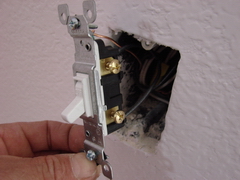» Need Electrical Help? Ask the Electrician
Switch Box and Flush Lights
|
By Dave Rongey
Summary: Electrical Lighting Question: An electrician wired a single pole switch box to two ceiling flush mount fixture boxes. I can't figure out what they did to hook it all up now that I finished the room. © By: Dave Rongey |
How to Wire a Switch Box and Flush Lights
Wiring a Switch Box and Flush Lights.
An electrician wired a single pole switch box to two ceiling flush mount fixture boxes. I can't figure out what they did to hook it all up now that I finished the room. All wires are Romex 12/2.
Fixture 1 seems to have the source power, with one spliced Romex end with electric tape wrapped around the Black and White. There is a second Romex cable here, presumably to head down to the switch.
Fixture 2 has a single Romex end, presumably leading to the switch box. In the switch box there are 3 romex cables. One was marked \ feed\ , which I think would lead to the fixture box at Fixture 1. So I can't figure out why there are 3 cables in the switch box and how to wire this.
Thanks, Dave
Hi Dave - Great Electrical Repair Question!
Dave - In order to positively identify the wiring you will need to use an ohm meter.
Here is a procedure that should help you. I have also added a link below to wiring diagrams which may help you understand how this circuit may be wired:
- How to Identify Light Fixture and Switch Wiring. This article will help you identify a pair of wires with the power off.
- You will be using a Tester that will send a small amount of voltage through the wires which will produce a reading or tone , depending on the meter you will be using.
- Common Ohm Meters or Signal Testers: Volt / Ohm Meter - Required: Volt / Ohm Meter Wire connector First: Be sure the circuit is OFF and clearly labeled that the circuit is to Stay Off while you are conducting these checks.
- *Verify that the circuit is in fact OFF using a Volt Meter or Circuit Tester.
After you have verified the power is off proceed.
Ohm Meter Setting:
Set your Ohm Meter to measure a low resistance setting such as Rx1K or 1000 Ohms. Touch the test leads together to test your meter, you should get a 0 reading which means there is zero resistance between the two test leads. Identifying a set or pair of wires: Select the pair of wires you need to identify at one location. Remove the insulation back about one half inch. Twist a wire connector on these two wires creating a temporary splice. Next: Select one of the pairs of wires you are working with. Remove the insulation back about one half inch.Testing with the Ohm Meter:
Now using the ohm meter place the one test lead to one wire, and the other test lead to the other. If you get a 0 resistance reading go to the pair of wires where the wire connector creates the temporary splice and remove the wire connector. Re test the ohm meter on the other pair of wires and see if you still get the 0 reading. If there is no 0 reading then you have identified this pair of wires. Label this pair of wires and proceeded with the test to identify any other pairs of wires.
For more information, see the wiring diagrams
The Safest Way to Test Electrical Devices and Identify Electric Wires!The Non-Contact Electrical TesterThis is a testing tool that I have had in my personal electrical tool pouch for years, and is the first test tool I grab to help identify electrical wiring. It is a Non-contact tester that I use to easily Detect Voltage in Cables, Cords, Circuit Breakers, Lighting Fixtures, Switches, Outlets and Wires. Simply insert the end of the tester into an outlet, lamp socket, or hold the end of the tester against the wire you wish to test. Very handy and easy to use.
The Quickest Way to Check for Faulty Electrical Wiring!The Plug-In Outlet TesterThis is the first tool I grab to troubleshoot a problem with outlet circuit wiring. This popular tester is also used by most inspectors to test for power and check the polarity of circuit wiring. It detects probable improper wiring conditions in standard 110-125 VAC outlets Provides 6 probable wiring conditions that are quick and easy to read for ultimate efficiency Lights indicate if wiring is correct and indicator light chart is included Tests standard 3-wire outlets UL Listed Light indicates if wiring is incorrect Very handy and easy to use.
Strip Off Wire Insulation without Nicking and Damaging the Electric Wire!The Wire Stripper and Wire CutterMy absolute favorite wire stripping tool that I have had in my personal electrical tool pouch for years, and this is the tool I use to safely strip electrical wires. This handy tool has multiple uses: The wire gauges are shown on the side of the tool so you know which slot to use for stripping insulation. The end of the tool can be used to grip and bend wire which is handy for attaching wire onto the screw terminals of switches and outlets.. The wire stripper will work on both solid and stranded wire. This tool is Very Handy and Easy to Use. |
||
Switches Parts and AccessoriesLight Switch Single Pole 3 Way Light Switch 4 Way Light Switch Switch and Outlet Combo Dimmer Switch |















